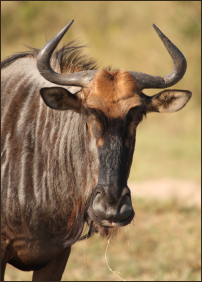Our Research
 Migratory grazers must move between ranges each year, and make daily movements to locate food, but landscape fragmentation and other obstacles to movement are increasing. Climate change is also making droughts more frequent and extreme, requiring animals to move farther to locate sufficient food. How wildlife populations are affected by these opposing effects is of interest. Researchers from the US and Kenya will be placing 45 collars on wildebeest in three conservation areas in Kenya. These collars contain global positioning devices that allow tracking of animal movements. Future landscape fragmentation in the areas will be modeled. A model will be constructed that will allow researchers to simulate movements of individual wildebeest within each population. Landscape fragmentation and the frequency of droughts will be varied in simulations to quantify potential effects of land use intensification and climate change on migratory wildebeest populations.
Migratory grazers must move between ranges each year, and make daily movements to locate food, but landscape fragmentation and other obstacles to movement are increasing. Climate change is also making droughts more frequent and extreme, requiring animals to move farther to locate sufficient food. How wildlife populations are affected by these opposing effects is of interest. Researchers from the US and Kenya will be placing 45 collars on wildebeest in three conservation areas in Kenya. These collars contain global positioning devices that allow tracking of animal movements. Future landscape fragmentation in the areas will be modeled. A model will be constructed that will allow researchers to simulate movements of individual wildebeest within each population. Landscape fragmentation and the frequency of droughts will be varied in simulations to quantify potential effects of land use intensification and climate change on migratory wildebeest populations.
Wildebeest migration fascinates the public, but remarkably little is known about individual movements, and how fragmentation and climate change interact to alter movements is unknown. These results will shed light on effects on other mobile grazers as well, including livestock, and address sustainability in landscapes shared by wildlife and humans. Broader impacts include: three graduate students trained, results used in university courses, publications produced, land managers in Kenya informed, information shared with citizens from Kenya, the US, and elsewhere, and novel modeling approaches developed.










